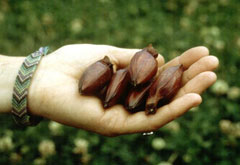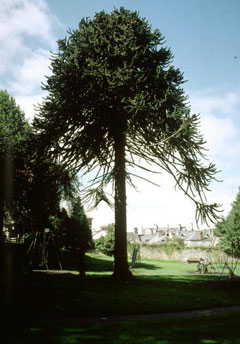 |
|
(c) 2010 Ken Fern & Plants For A Future |
 |
| (c) 2010 Ken Fern & Plants For A Future |
Translate this page:
Summary
Form: Pyramidal.
Physical Characteristics

 Araucaria araucana is an evergreen Tree growing to 30 m (98ft) by 15 m (49ft) at a slow rate.
Araucaria araucana is an evergreen Tree growing to 30 m (98ft) by 15 m (49ft) at a slow rate.
See above for USDA hardiness. It is hardy to UK zone 8 and is not frost tender. It is in leaf all year, in flower from June to July, and the seeds ripen from September to October. The species is dioecious (individual flowers are either male or female, but only one sex is to be found on any one plant so both male and female plants must be grown if seed is required). and is pollinated by Wind. The plant is not self-fertile.
Suitable for: light (sandy), medium (loamy) and heavy (clay) soils and prefers well-drained soil. Suitable pH: mildly acid, neutral and basic (mildly alkaline) soils. It can grow in semi-shade (light woodland) or no shade. It prefers moist soil. The plant can tolerate maritime exposure.
UK Hardiness Map
US Hardiness Map
Synonyms
A. imbricata. Pinus araucana.
Plant Habitats
Woodland Garden Canopy;
Edible Uses
Edible Parts: Seed
Edible Uses:
Seed - raw or cooked. Rich in starch[183]. The seed is soft like a cashew nut and has a slight flavour of pine nuts. This is a delicious seed and it makes very pleasant eating. It is a food that can easily be eaten in quantity and can be used as a staple food in the diet[K]. Fairly large, the seeds are about the size of an almond and can be 3cm long x 1cm wide. They are harvested in the autumn and, when kept in cool, dry conditions will store for at least 9 months[K].
References More on Edible Uses
Medicinal Uses
Plants For A Future can not take any responsibility for any adverse effects from the use of plants. Always seek advice from a professional before using a plant medicinally.
Vulnerary
A resin obtained from incisions in the trunk is used in the treatment of ulcers and wounds[46, 61, 139].
References More on Medicinal Uses
The Bookshop: Edible Plant Books
Our Latest books on Perennial Plants For Food Forests and Permaculture Gardens in paperback or digital formats.

Edible Tropical Plants
Food Forest Plants for Hotter Conditions: 250+ Plants For Tropical Food Forests & Permaculture Gardens.
More

Edible Temperate Plants
Plants for Your Food Forest: 500 Plants for Temperate Food Forests & Permaculture Gardens.
More

More Books
PFAF have eight books available in paperback and digital formats. Browse the shop for more information.
Shop Now
Other Uses
Resin Shelterbelt Wood
Very tolerant of maritime exposure, trees can be grown as part of a shelterbelt, though they are very slow growing and have an open canopy and so do not give a lot of shelter[75, 81]. A resin is obtained from incisions in the trunk. This is used mainly for medicinal purposes[46, 61, 139]. Wood - pale yellowish, good quality, takes a beautiful polish. Used for joinery and carpentry[1, 46, 61, 139].
Special Uses
Carbon Farming Food Forest
References More on Other Uses
Cultivation details
Management: Standard Regional Crop Staple Crop: Balanced carb
Landscape Uses:Pest tolerant, Aggressive surface roots possible, Specimen. Prefers a deep well-drained soil[11, 200]. Dislikes hot dry soils[1]. Dislikes atmospheric pollution[166]. Very tolerant of maritime exposure and salt laden winds[75, 81]. The monkey puzzle is a very slow growing tree that can take 5 - 10 years before it even gets above grass height and then grows around 35cm a year[185]. New growth takes place from late June to September[185]. The seed forms a staple food for the native Indians in regions where it grows in Chile, it is also sold in local markets there[46, 139]. This tree has an excellent potential to become a commercial crop in the western parts of Britain, it is high yielding, has large tasty seeds and is easily harvested. Its main disadvantages are its slow rate of growth and the time it takes before the first crop is produced - this can be up to 40 years from seed though we have often seen plants less than 20 years old produce cones[K]. The plant is dioecious so at least one male plant needs to be grown for every 5 - 6 females - unfortunately there is no way of telling the sex of the tree until it flowers. There are means of vegetative reproduction and it might be possible to produce clones of known sex in the future - these will probably come into bearing at an earlier age. If you have the space to plant at least 5 trees, and the foresight, this is a tree that will be a very valuable food crop in the future[K]. It is said that 18 good-sized trees can provide enough for an adult's sustenance all year round[2]. Plants grow best in S.W. England and along the west coast of Britain where they produce seed regularly and abundantly[11, 80]. Female cones take 2 - 3 years to mature and break up at the end of the year[185]. They contain up to 200 large seeds. Plants self-sow in Cornwall[80]. We have records of trees regularly producing good crops of seeds in various sites in Cornwall, Devon and the west coast of Scotland. We also have one report of an excellent crop in 1997 from trees at Alvaston Castle near Derby and of a tree in Bedfordshire producing a heavy crop[K]. Trees are notably susceptible to honey fungus[81, 200]. Unlike most conifers, this tree can be coppiced[81]. Special Features:
Attractive foliage, Not North American native, Inconspicuous flowers or blooms. The plant is heat tolerant in zones 12 through 6. (Plant Hardiness Zones show how well plants withstand cold winter temperatures.
Plant Heat Zones show when plants would start suffering from the heat.
The Plant Heat Zone map is based on the number of "heat days" experienced in a given area where the temperature climbs to over 86 degrees F (30°C).
At this temperature, many plants begin to suffer physiological damage. Heat Zones range from 1 (no heat days) to 12 (210 or more heat days).
For example Heat Zone. 11-1 indicates that the plant is heat tolerant in zones 11 through 1.) For polyculture design as well as the above-ground architecture (form - tree, shrub etc. and size shown above) information on the habit and root pattern is also useful and given here if available. The plant growth habit is a standard with a non-suckering single trunk [1-2]. An evergreen.
Carbon Farming
-
Management: Standard
Plants grow to their standard height. Harvest fruit, seeds, or other products. Non-Destructive management systems.
-
Regional Crop
These crops have been domesticated and cultivated regionally but have not been adopted elsewhere and are typically not traded globally, Examples in this broad category include perennial cottons and many nuts and staple fruits.
-
Staple Crop: Balanced carb
(0-15 percent protein, 0-15 percent oil, with at least one over 5 percent). The carbohydrates are from either starch or sugar. Annuals include maize, wheat, rice, and potato. Perennials include chestnuts, carob, perennial fruits, nuts, cereals, pseudocereals, woody pods, and acorns.
References Carbon Farming Information and Carbon Sequestration Information
Temperature Converter
Type a value in the Celsius field to convert the value to Fahrenheit:
Fahrenheit:
The PFAF Bookshop
Plants For A Future have a number of books available in paperback and digital form. Book titles include Edible Plants, Edible Perennials, Edible Trees,Edible Shrubs, Woodland Gardening, and Temperate Food Forest Plants. Our new book is Food Forest Plants For Hotter Conditions (Tropical and Sub-Tropical).
Shop Now
Plant Propagation
Seed - best sown as soon as it is ripe in a cold frame[134] or it can be stored cool and moist then sown February in a greenhouse[78, 80]. Although the plants are quite cold-tolerant, the root systems of seedling plants can be damaged in spells of very cold weather so give some extra protection at this time if necessary. The seed usually germinates in 1 - 2 months at 15°c[134]. As soon as they are large enough to handle, prick the seedlings out into individual pots. The plants have a rather sparse root system and are best placed in their final positions as soon as possible. Give them some protection for their first winter[K]. Cuttings of half-ripe wood, May to July in a cold frame. Only epicormic side-shoots should be used, normal side-shoots do not develop properly[81]. An epicormic shoot is one that develops from a dormant bud on the main trunk of the tree[K].
Other Names
If available other names are mentioned here
Native Plant Search
Search over 900 plants ideal for food forests and permaculture gardens. Filter to search native plants to your area. The plants selected are the plants in our book 'Plants For Your Food Forest: 500 Plants for Temperate Food Forests and Permaculture Gardens, as well as plants chosen for our forthcoming related books for Tropical/Hot Wet Climates and Mediterranean/Hot Dry Climates. Native Plant Search
Found In
Countries where the plant has been found are listed here if the information is available
Weed Potential
Right plant wrong place. We are currently updating this section.
Please note that a plant may be invasive in one area but may not in your area so it’s worth checking.
Conservation Status
IUCN Red List of Threatened Plants Status :

Growth: S = slow M = medium F = fast. Soil: L = light (sandy) M = medium H = heavy (clay). pH: A = acid N = neutral B = basic (alkaline). Shade: F = full shade S = semi-shade N = no shade. Moisture: D = dry M = Moist We = wet Wa = water.

Expert comment
Author
(Molina.)K.Koch.
Botanical References
11139200
Links / References
For a list of references used on this page please go here
Readers comment